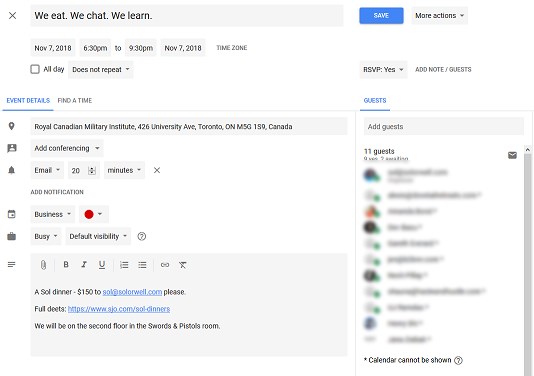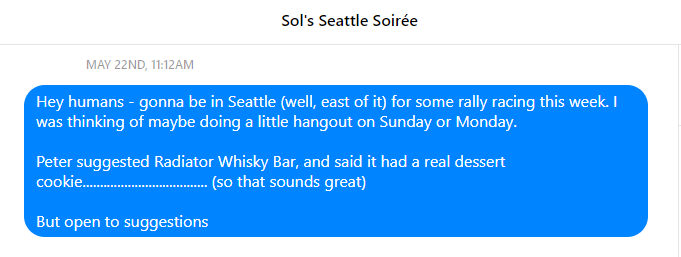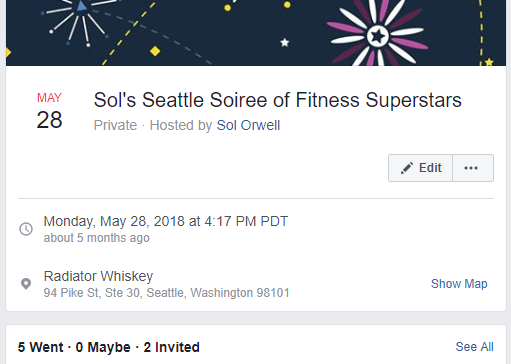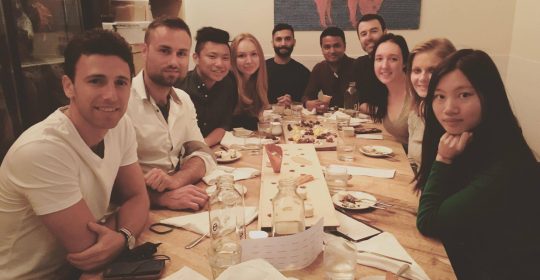I stopped attending events in 2018.
I took a step back and asked myself: why am I really attending events?
If we’re honest with ourselves, the biggest value we get from an event is the (like-minded) people there and the conversations that occur.
It’s rarely the speakers (you can find their talks on YouTube). It’s the connections and the ability to get into the specific details.
So if that’s the real why for going to an event, it begs to wonder: how can you ensure more consistent conversations that move the needle for you? How can create a position that allows you to have the conversations that you want with the people who you wish to converse with?
Pretty easy answer:
By being the hub.
The simplest way to become a hub is to bring people together.
And the easiest way to bring people together?
With food.
Humans connect over food. Break bread to build bonds.
This article is going to break down how hosting dinners helps you become the hub.
Be the hub
There are a few obvious benefits of hosting your own dinners (or lunches/breakfasts – the same principles apply – and in some situations, lunches/breakfasts may be more advantageous. More on that later).
1. You set yourself apart from everyone else.
The dirty secret is most people give a lot of lip service to “getting together,” but few make it happen. By being a do-er and not just a talk-er, you are not like everyone else.
2. You build up a reputation.
People talk. I cannot tell you how many people I’ve met who had heard of me through Person X or Person Y; A reputation as someone who is connected will precede you.
When you build a reputation, you’re allocating yourself real estate space in someone else’s mind. In Toronto, I’m not just associated with cookies, but also with hosting dinners with badass entrepreneurs.
It’s strong enough that when people come to Toronto, others tell them “You gotta meet Sol” –

3. Others follow your lead.
Almost a dozen people have been to my dinners and were inspired to host their version.
The beauty of dinners is there is no right way to do it. You could have an intimate four-person dinner. You could have Jeffersonian dinner. You could have assigned seating. (More on all of this later). But as the catalyst, you’re getting others to do the same.
I was already meeting a bunch of people via chocolate chip cookie/coffee meetings, but was inspired by my buddy Jayson Gaignard to level it up.
4. Your connections make you look good!
I’m about as anti-“selfie” as you can get, and am off-put by people who take selfies with everyone to build social proof on social media.
With that said, the simple truth is that by hanging out with smart people makes you look good. “Birds of a feather flock together” and all that jazz.
If you saw someone you respected hanging out with someone you didn’t know, wouldn’t you automatically assume that the unknown person must be pretty smart too?
5. Opportunities open up.
A very frequent occurrence due to my dinner is Person X will attend and then immediately introduce me to Person Y.
People talk about how your “your net worth is your network,” but they don’t realize that your network is not people you know; your network is the people you know who are willing to help you.
Just look at my charity chocolate chip cookie off. In 18 months we went from $950 raised to over $100,000. If I had to give credit to one thing for such stupendous growth, it would be because of the dinners I host.
Becoming a hub by hosting your own dinners is an absolute no-brainer. There is a whole host of benefits that arise from bringing humans together.
Okay, so you’re ready to host a dinner. Now what?
Curating & Considerations
Lots to think about.
Purpose and theme
When you’re just getting started, it makes sense to have a purpose or theme behind your dinner.
Your dinner could be founders. It could be focused on topic X (eg: marketing). It could be around a single issue (optimizing your morning routines). The goal here is to help guide the conversation – by having a specific theme, you can prep questions and lead back to a “north star” of discussion. You will be the nervous the first time, so you want to be prepared with questions/discussions to have. A good approach is a Jeffersonian dinner, where the conversation is around a singular topic and by the entire group (no individual side conversations).
Have a purpose/theme to help focus the conversation.
Lunch vs dinner
I want to cover this quickly – in general, I prefer dinners:
- Everyone is more relaxed
- There’s a lot more time
- The meals are more delicious
There is one downside for dinners: it’s much harder to get professionals (especially those married with young kids) to come out. Taking three hours away from someone is not a simple request.
Furthermore, rush hour can hit you hard around dinner time. So that’s another consideration.
My friend Derek has hosted roughly one billion lunches in DC. He has an organization called Cadre for service professionals (think: wealth management, accountants, lawyers, etc). They’re all about lunches – smaller time commitment, in the middle of the workday (thus a part of “work”), and it doesn’t take away any of their precious time from family. Furthermore, DC can be a nightmare during rush hour, so no need to worry about that.
The same applies for breakfasts.
While dinners is where people usually relax the most, lunches can be the better choice depending on the audience and time constraints.
Your relationships
Once you know what you wanna focus your dinner on, you need to get people to attend.
The simplest way is to invite three friends of yours that are interested in your theme and invite them out. Even if they know each other, you can make sure the dinner is fruitful because it’s focused around a topic.
A simple four-person dinner.
People always get impatient and want to start big. Similar to learning to walk before running, I highly recommend you do something intimate and small with people you know to get more comfortable being a host.
Start small with people you know to get a feel for it.
Legwork
Make sure you do the work before you invite someone. Check them out on social media – are they traveling? Did they have a big win (or a really big loss)? By being aware of what is going on in their life, your approach becomes more personalized. And nothing beats personalization.
At a minimum, if someone is traveling, you can let them know you were going to invite them, but since they’re away, you wish they’re having a ball.
Don’t blindly invite people. See what they’re up to first.
Inviting friends
It’s easy to fall back and invite your close friends when starting.
Be careful. Your dinner is a professional event, and you have to make sure your friends take it as such. I am very informal with people, but that’s a tone I set; people know I’m still serious about what I do.
Friends can be a comfortable invite, but make sure they are the right fit.
Intake form
The people you invite can span the entire gamut of relationships – from someone you know really well, to someone you cold-invited.
My buddy Jayson hosts dinners that are very intimate (just a few people) and also ones that are quite large (over 50 people).
For larger dinners, Jayson has an intake form. The idea was to immediately bring to the fore their biggest wins, what they were working on, and any struggles they were having.
(He also has a great book on hosting dinners).
If you’re going for a tone that is very professional/networking, it may be worthwhile to have an intake form. I have people fill out an intake form for my Chocolate Chip Cookie Offs; this helps me line up their expectations with what I’m offering, and also lets me facilitate useful introductions.
What goes into the intake form? Whatever you think is relevant – someone’s biggest success, their biggest headaches, what they’re most proud of, etc.
An intake form can be a useful way to explicitly discern what people have done and are looking to do.
Who pays for dinner?
I paid for the first few dinners I hosted.
And then I thought to myself – why? I have no services to offer. None of my businesses rely on entrepreneurs (which are the kinds of people I invite to my dinner).
Furthermore, I like keeping things simple.
Thus, make everyone pre-pay.
I opt for pre-pay because the cost of the dinner is a fixed cost – we book a private a room for X number of people, so even if someone cancels, I still have to pay (and many private dining rooms have minimum charges).
Furthermore, it makes the entire dinner process far smoother – no one has to worry about getting the attention of the wait staff to pay for their meal.
More importantly, by having everyone pay, I’m signaling that while I’m organizing this, there is no underlying agenda that I have. If I were paying for dinner people would rightfully wonder what my motivations were.
Having everyone pay for their share (and ideally pre-pay to make the experience smoother) keeps things simple.
A great example of doing it the other way is what Chris Winfield and Selena Soo do: they host monthly dinners of mostly journalists and editors and helps them connect with each other. Chris then hosts an event called Unfair Advantage, in which he helps others get press. And the people who speak at his event? The very same journalists and editors.
There are advantages of paying for the dinner or having others pay for it. Figure out which works best for your business and be explicit about who pays.
Charity
Once I was established, I started to charge an extra $50 per person and then donate the extras to a local non-profit. I’m leveraging my reputation to help funnel an additional ~$10000/year to charity!
Once you’ve built up the relationships, you can leverage your dinners to also make a positive impact.
Before the Dinner
Before you even start, you gotta figure out some logistics:
How many people?
The dynamic changes as the number of people change. From my experience (total # of people):
- 2: very intimate
- 3-5: can have one main conversation
- 6-10: can have one main conversation or a few more intimate conversations
- 11+: multiple conversations of 2-4 people
Once you hit 6+, you likely want to have some Forced Mingling (more on that below). At 10+ it is a no-brainer (unless you have Assigned Seating – also more on that below)
I like 12-14 as my sweet spot. It lets me bring in people from disparate backgrounds, and it ensures that someone meets at least a few new people. I’m more interested in people meeting different and interesting people than one big primary conversation.
When starting, sticking with 4 for your first dinner is likely best.
As the number of people increases, the dynamic of the conversation and interactions changes.
Where will the dinner be? And will it be in a Private Dining Room (PDR)?
The location and type of food can have a huge impact.
Think about it akin to dating. You’re unlikely to take someone on a first date to a BBQ joint – eating ribs can be messy and can make people self-conscious.
Furthermore, as the goal is to have a conversation, go to a place that is too loud, and the discussion becomes stilted, and everyone starts picking away at their food.
Ideally, you will get a private dining room (PDR) – it’s intimate, it’s exclusive, and you can control the loudness around you. Additionally, you can find some interesting PDRs in your city. My two favourite spots in Toronto include a basement room in an Italian restaurant that has a beautiful live-edge table and no cell phone service, and an invite-only military institute with a gorgeous “swords and pistols” room.
A few examples:
If you’re hosting a smaller dinner (5 or 6 people), I highly recommend a circular table. A rectangular table works for 2-4 and then 7+ people.
You also have to consider how many people a table can hold – you don’t want people crushed together, but you also don’t want them to spread out too far out.
The location where you have your dinner is important; a good location helps spur conversations. Ideally get an intimate private dining room (PDR)
Know your menu
An extension of the location is the menu.
Part of why I like to prepay is so we can have a prix fixe menu (a simplified set menu usually with an appetizer, main, and dessert). This way everyone can see the menu beforehand, and any allergies can be dealt with.
I’m also a big fan of family-style meals. That usually takes care of any allergies as the wide variety of dishes means anyone without ridiculous dietary restrictions can find something to eat.
(Personally, if you have a dietary restriction based on emotions, I likely won’t ever re-invite you to dinner; the goal is to enjoy food, not deal with your crazed nonsense food finickiness).
You can of course still opt to use the regular menu and let everyone order their food and have individual bills (unless you’re covering it).
By having a prix fixe family-style menu you can more easily deal with any allergies and keep things moving faster.
Inviting people
I send a calendar invite to everyone for the upcoming dinner.
I keep the attendees anonymous – I want people to come with an open mind and ready to meet new people without any preconceived objectives.
In the calendar invite I link to a page that has all details (payment, etc) and my contact info. I also note in the invite to let me know of any allergies.
(I talk to a lot of people on Messenger, but since I don’t have it on my phone, I make a note to text me if any issues).
I usually send out dinner invites a month before it happens. Two weeks before I follow up with everyone on attendance/payment, and then do it again a week before.

If you don’t respond with 48h to go, I cancel the invite.
One final reminder is sent 24-48h before.
You can also use a Facebook Event as a simple invite too.
Send a calendar invite ahead of time to ensure people can attend.
Loud people versus quiet people
One thing to consider when inviting a bunch of people is not having too many loud voices and not having too many quiet voices.
Loud voices can dominate the conversation (for better or for worse) which can suppress some of the side-conversations that happen.
Quiet people can easily withdraw when presented with too many people.
So just keep it in mind.
You want to have a balanced set of people so that conversations freely happen.
Co-host?
When starting, it may be worthwhile in getting a co-host so you don’t feel too stressed in bringing people together and facilitating conversations. As I write this, I’ve never had a co-host, but it can be advantageous in off-loading some of the responsibilities.
It could be useful to have a co-host to take some of the pressure/stress off of you.
One-pager
I have a simple one-page document that we send out to the restaurant that breaks down our expectations. We find by having our expectations in writing and being clear and concise ensures the entire night goes smoothly.
This has of course been developed over dozens and dozens of dinners and is personalized to my approach.
As you get more comfortable with how you approach things, create a document you can send to where you’re hosting your dinner so they know exactly what the expectations are.
During Dinner
Okay – it’s game time. Get ready to mingle.
Showing Up
I like to show up roughly 15 minutes before. It lets me see that the space is good, go over the process with the person-in-charge (eg: there will be one bill for the food, and then everyone will have individual drink tabs, etc).
Furthermore, it’s a bit of a calm-before-the-storm. It lets me sit there, get excited that people are coming out because I invited them, and that we’re about to eat some delicious food!
Also if you aim to arrive early, even if you get delayed (unexpected traffic, an urgent phone call, etc), at worst you’ll be on time (instead of late).
Arrive early to ensure that everything looks good and gather yourself
Assigned seating
Depending on the purpose of your dinner, you may want to go with assigned seating. If you know Person A and B should talk about X, sit them next to each other.
One benefit of assigned seating is people will know that you sat them next to each other for a reason and are more likely to put in the effort to get to know their neighbors.
I am an ad-hoc kind of guy, so I just let people sit wherever. I have one strict rule – couples/co-founders are never allowed to sit together.
Assigned seating means you’ve purposefully put people together (which means they are more likely to put effort into conversation).
Purchase some alcohol
Alcohol is the greatest social lubricant in the world.
At the same time, when it comes to a gathering of people, most are loathe to make the first move. And that includes ordering alcohol (typically wine or cocktails at dinners).
So I usually buy a few bottles of wine (one red one white) and the waiter starts offering those. When those are finished, then people are more likely to continue ordering alcohol.
Order some alcohol (usually wine) to get people more comfortable.
Bring a notepad
During the dinner, people will say interesting things. If you’re doing introductions, little things will come out that you may want to make a note of for the future.
Bring a notepad and write that all down.
Phones suck. They’re distracting and they’re anti-social.
Bring a notepad to jot down anything interesting mentioned
Introductions and questions
This is the big one that trips everyone up. OK – we’re at dinner. Now what?
There are a million ways to get people comfortable. You can introduce everyone at the dinner (provided you know them well enough). You can mention something from their intake form (if you did one). You can have everyone do their own introduction. You can even ask them questions as you do.
For me, the way people get comfortable is when they get personal. And the “what do you do” question is overrated; after all, your dinner is a curated event.
After I introduce what my agenda is (bringing interesting entrepreneurs from disparate bubbles together), what I do is have everyone answer the three following questions:
- What do you do? Here’s the trick: I bring a three-minute sand-timer. You have three minutes to say what you do, and that’s it. It forces people to keep things brief and focus on what’s important.
- What’s a personal victory you’ve had in the past 60 days? My favorite one. I emphasize that this is personal, not professional; it lets you know what someone cares about.
- Icebreaker question. There are a bunch of places where you can get “icebreaker questions.” I use a stack of questions that I pieced together via Jayson Gaignard, Noah Kagan/Justin Mares, and my own. Each question is pretty unique, and the answers end up being a nice window into how someone thinks.
One thing to note – people will be shy. They will be humble. It is on you to set the tone. I usually say something to the effect of: “Listen, I invited you to this dinner because you know your shit. If you said ‘I made ten million dollars last month’ no one here will think ‘what a pompous jerk.’ Instead, everyone will want to know how you did it. So please – don’t be humble, be honest.”
I do jump in if I have to when someone is being extra shy. For example, my friend Jocelyn is a co-founder of How to Cake It, which has almost 4 million subscribers on YouTube. Yet she never mentions it when introducing herself. It went so far that I’ve threatened to ban her from future dinners if she doesn’t fess up without me having to prod her.
One thing you may have noticed missing is “what do you need help with?” It’s an important question, but the problem is asking it right off the start is tough for most people (again: humble/shy). I’d save it for later.
I also loathe the “what do you do?” question. I’m far more interested in who you are.
The introduction sets the tone. I find focusing on the personal helps people open up, and by establishing an informal tone, it also helps ease any nervousness.
Forced mingling
The worst people at any event are the ones who, when you’re talking to them, you can see their eyes darting everywhere. They’re there to mingle and are looking for someone “better” to talk to.
In a way, you can’t blame them. Any time you hear a group of people laughing you want to know what’s so hilarious.
To alleviate any FOMO at my dinners, and to ensure that people meet others, I usually make everyone change seats twice during the night.
The three “segments”:
- Start until entrees arrive
- Entrees until dessert
- Dessert and after
This is partially why I don’t do assigned seating.
People will often end up sitting next to a person they know; conversing with a friend “warms them up” so that when I force them to change seats, they’re more in the mood to continue talking.
This is also why I tend to prefer family-style. Since everyone is sharing, it’s much easier to send everyone moving around.
Plus, at times two people may be seated next to each other who don’t click (it’s unavoidable). By getting everyone to change seats you ensure that everyone gets a new conversation going.
Force people to meet new people by changing seats. This means new people, new conversations, and a better night out for everyone.
Take a picture during dessert
Here’s a simple pro-tip – you want a picture of your dinner. And the best time to get it is when dessert is served.
By this time everyone’s had some delicious food, everyone’s been having interesting conversations, and there’s delicious dessert right in front of them. It’s gonna leave everyone in a good mood.
Depending on my time constraints, I sometimes even grab a SOLCOOKIE.
The perfect time to take a group picture is when dessert is served.
What do you need help with?
OK, so dessert has come out. Now is the perfect time to ask “what do you need help with?”
With that said, the question can be a bit tough to answer. A softer question would be “What are you currently working on? What are you currently struggling to solve?”
With people enjoying dessert, have everyone answer the “what do you need help with?” question. And make sure to mark them down in your notepad.
Savour it
So the interesting part about my dinners is that I spend the least amount of time talking to others. And it’s not because I’m “facilitating” or stressed out.
Nah – I like taking a moment to step back, sit there, and enjoy what’s in front of me.
I’ll look around and see a dozen successful entrepreneurs – from all industries, genders, and ethnic backgrounds – all having animated conversations with each other.
All because I put in a modicum of effort to bring them together.
I sit there and pat myself on the back and grin like a Cheshire cat.

Savour the fact that you brought people together
The Irish Exit / French Goodbye
I’m an old man. And as an old man, the secret to my youthful appearance is ample sleep.
(Man do I love my sleep).
So by hour #3, I’m usually ready to go home.
And most people are not.
And this is understandable. I easily host 20+ and attend 30+ dinners in a year. For me, this is another day. But for most people, this is an atypical night out.
Yet if I make a show to be leaving, everyone then takes it as their cue that they need to leave too.
So what I do now is I get up and leave.
That’s it. No goodbye. No fanfare. The Irish Exit, aka the French Goodbye.
I now have a reputation for it, and people know to expect that at some point I will simply disappear, but they can continue to stay and chat.

There’s no reason the dinner needs to end if you need to leave. If the conversations are flowing freely, leave without a fuss.
After the Dinner
Great job – you hosted a delightful dinner replete with fascinating humans, stimulating conversations, and finger-licking good food.
You’re 90% done. Time to bring it home…
Connect everyone asap
Everywhere I travel I try to host a few dinners and drinks. I’ve noticed that the most successful people tend to thank me the next morning.
They don’t dilly-dally. They thank me and get it out of the way.
Do the same here. Connect everyone asap. I usually do it via email, and around noon (so at lunchtime people can read it over and reach out to anyone they want).
Remember that notepad you were writing interesting tidbits and any “what do you need help with” requests?
Now’s the time to transfer them from paper to the digital world.
Make sure you connect everyone asap the next day.
Solicit feedback
It never hurts to ask for feedback. With that said, unless you have nitpicky friends in your life like me (or brutally honest ones like UJ), you’ll likely get fluff.
Set up an anonymous survey (eg via Google Forms) and ask people for any and all details on what they liked and what could be improved.
Solicit feedback, but do it anonymously so people can be completely honest.
Share on social media
Look, I hate selfies. But if you brought people together and organized a dinner, you should be damn proud of it (I hope you savored it).
So – post it on social media. Share your experience. Tell people what you got out of it.
At the beginning of this article, I talked about how the connections make you look good – here’s when you get to show it off.
I usually post the picture noon the next day, and when I send out the email connecting everyone, I link to the picture. Like the example pictures above.
Share the picture from your dinner on social media
Year reminder
One of the side benefits of posting it on Facebook is on their Memories page you’ll get a yearly reminder of your dinner. It’s a great way to keep in touch with people.
And you’re done
Congrats. Bask in the fact that you’ve done something that 99% of people who talk about it never actually do.
Don’t make this too hard
Most of us tend to overthink and overcomplicate things. What I gave you was an incredibly thorough roadmap on how to do it yourself. It’s stuff I’ve been doing for years and thus I have amassed a lot of thought behind what I do.
The idea here is you take bits and pieces and apply it as needed.
A simple example: going to Seattle
I started writing this article en-route to Seattle.
About a week before I left, I posted this on FB:
https://www.facebook.com/sorwell/posts/10156340823899534
A few people in fitness messaged me, so I messaged the five that showed interest in a simple group message on FB:

After we came to a level of consensus, I created this FB event and invited them:

Bam. That took… 10 minutes of effort?
And yeah I used a FB event instead of a calendar invite – both work just fine.
It doesn’t always have to be fancy.
The magic is simply in stepping up and bringing humans together. The rest is just details. And by doing so, you set yourself up for future success.






Leave a Reply